An Example Game of Santa’s Baseball Solitaire
First Inning
Second Inning
Third Inning
Fourth Inning
Fifth Inning
Sixth Inning
The set up
To start, we’ve laid out the ace through nine of diamonds as the batting
order. Above this will be the scoreboard; at the end of each inning
we’ll move scoring cards up there. Below it is where we’ll play
cards for the current inning. And below that is our five card hand.
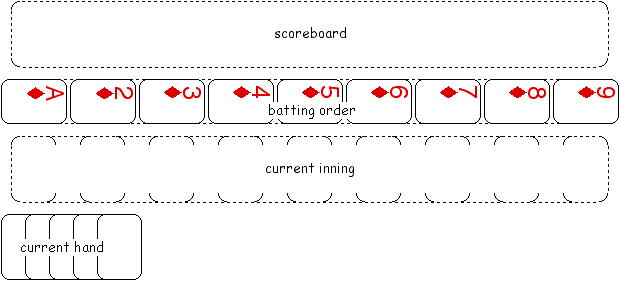
First Inning
The first batter up is number one (ace). We have no ace, so we will have to
make an out. Planning ahead, we can see that we’ll be able to score by
hitting a double with the 2s and driving in the run with the 4. The king and
the 7 are expendable, but we might be able to save the 7 for the second
inning. So we play the king as an out, face down. We show face down cards
here as purple, and for convenience we show the number of outs on the card.
We use yellow to show the card in hand that is being played.

We play both 2s for a double. We put the heart on top, so that we’ll get
an extra base when we play the four of hearts. The 2 is played straight up,
showing that the runner is on second base.

We have no three, so we have to throw away something. We might save the two
jacks, hoping to draw two more face cards to draw a walk for a future batter.
But we want to keep the 7 for next inning, so we toss a jack.

We play the 4 for a single. The runner on second gets an extra base (and
scores) because its suit matches the batter’s. We slant the 4 to the
right to show that the runner is on first. We turn the 2 sideways to show
that it has scored a run.

We have no five, so we throw away the jack and end the inning. We turn the
batting order 6 so that we’ll remember where to start the next inning.
Then we gather up the cards from the current inning and set them aside. Since
we scored one run, we place one of the cards in the scoreboard for the first
inning.
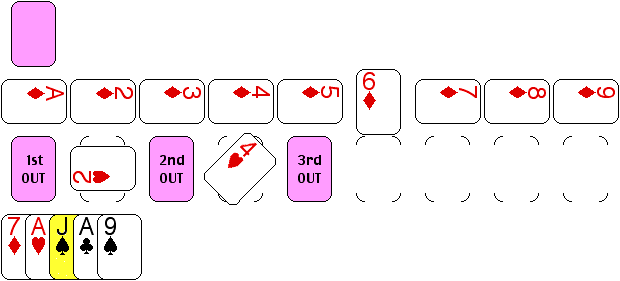
Second Inning
The first batter up is the number 6 hitter. This will be an out since we have
no six. But looking at our cards, we see we’ll be able to reach base
with batters 7, 9, and 1. But all our cards are good cards! What should we
throw away here? The best choice is to throw away a 7. We lose the chance to
hit a double; but with the hits from our 9 and 1 batters, the 7 batter will
score anyway.

Batter 7 hits a single.

We have no 8, so we’ll make another out. Tens can be used as sacrifice
bunts— if they match the suit of all runners. In this case we only have
one runner and the suit maches our ten, so we can bunt the runner to second.

Batter nine hits a single. The runner doesn’t match the batter's suit,
so he stops at third base. We slant the seven to the left to show that
it’s on third.

Batter one hits a double. The runner on third scores. We can choose either
hearts or clubs as the batter’s suit, but neither matches the runner on
first, so he has to stop at third.

We have no 2, so the inning will end with two runners on. We might be tempted
to keep face cards for a walk, but since we’re going to be holding the
pair of sixes for a while, we wouldn’t also be able to get the four face
cards needed for a walk. So we throw away a face card. To end the inning, we
turn the 3, gather up the cards, and put one card in the scoreboard for the
second inning.
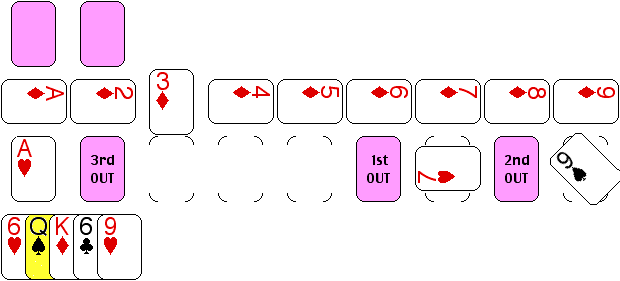
Third Inning
We start the third inning in the three slot. We see we have a double coming
up at position 6, but we don’t see anything good happening before that.
We make an out with a face card, and hope to draw a 4 or 5.

We throw away another face card, hoping to draw a 5.

We were lucky and drew a 5; but it’s the wrong suit (we needed a heart
or club to match the 6). If we play the 5 here and the double 6, we
won’t score unless we draw a 7 in those three cards. We’ve already
used two 7s so there are only five left (remember, one is used in the batting
order)out— the odds are against getting a 7. On the other hand, if we
make an out here, we can lead off the next inning with a double. We want to
save the 9 to drive in the 6. We’d also like to save the A to follow the
9. In fact, we’ll throw away the 6 of clubs, planning to score a run with
the 6-9-A. Note that we can’t throw away the 5 to make an out— it
would be a single.
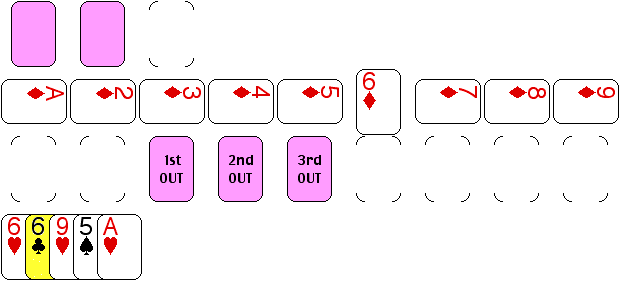
Fourth Inning
As planned, we lead off with a single

No luck drawing a 7 (good thing we didn't try to score last inning), so we
make an out.

We make another out, saving the 3 instead of the 5 since the 3 will come to
bat sooner.

We had planned a single for here, but in the meantime we drew a 9 so we get a
double instead. We put the heart on top so that runner 6 will score, and so
that the upcoming ace of hearts will drive in another run.

A single drives in the run.

The inning ends with a face card. Two more runs go into the scoreboard.
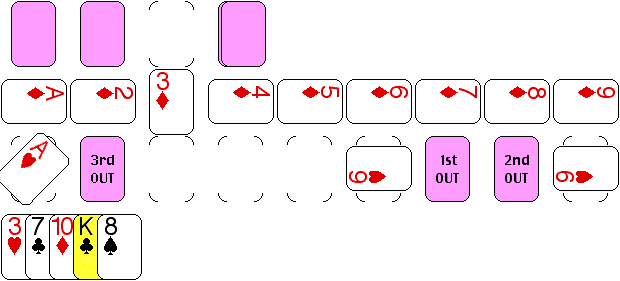
Fifth Inning
Batter three leads off with a double. We put the diamond on top so the next
batter can bunt him to second.

We use the ten for a bunt.

Batter five drives in the run with a single.

Batter six is out. We can see the next three batters will all reach base.

Batter seven singles, with the runner moving to second.

Batter eight singles. The runner on second scores while the runner on first
stops at second.

Batter nine singles, driving in the runner from second.

Back to the top of the order, but the leadoff man ends the inning. Three more
runs go on the scoreboard.
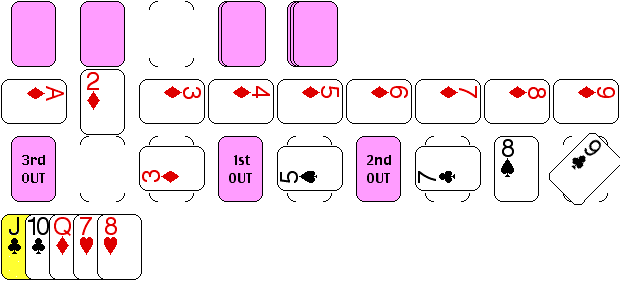
Sixth Inning
Prospects are poor for the sixth inning. Number 2 leads off, and we have
nothing better than a 7. Best we can hope for is to draw at least one base
runner so that we can use the 7-8-9 next inning with only one out. We throw
away the face card.

We throw away the ten.

We throw away the jack. Three up, three down. Even though we didn’t get
any runners, we drew a 5 which we can use next inning.
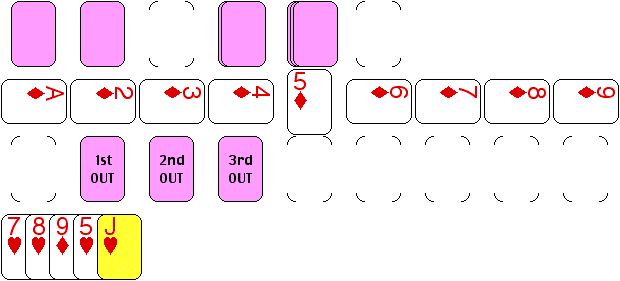
Looking ahead to the next inning, we see 5-7-8-9, so four batters will reach
with one out. It has the potential for a big inning. I’ll drop the
example here though, since I think the rules and strategy should be pretty
clear by now.



































